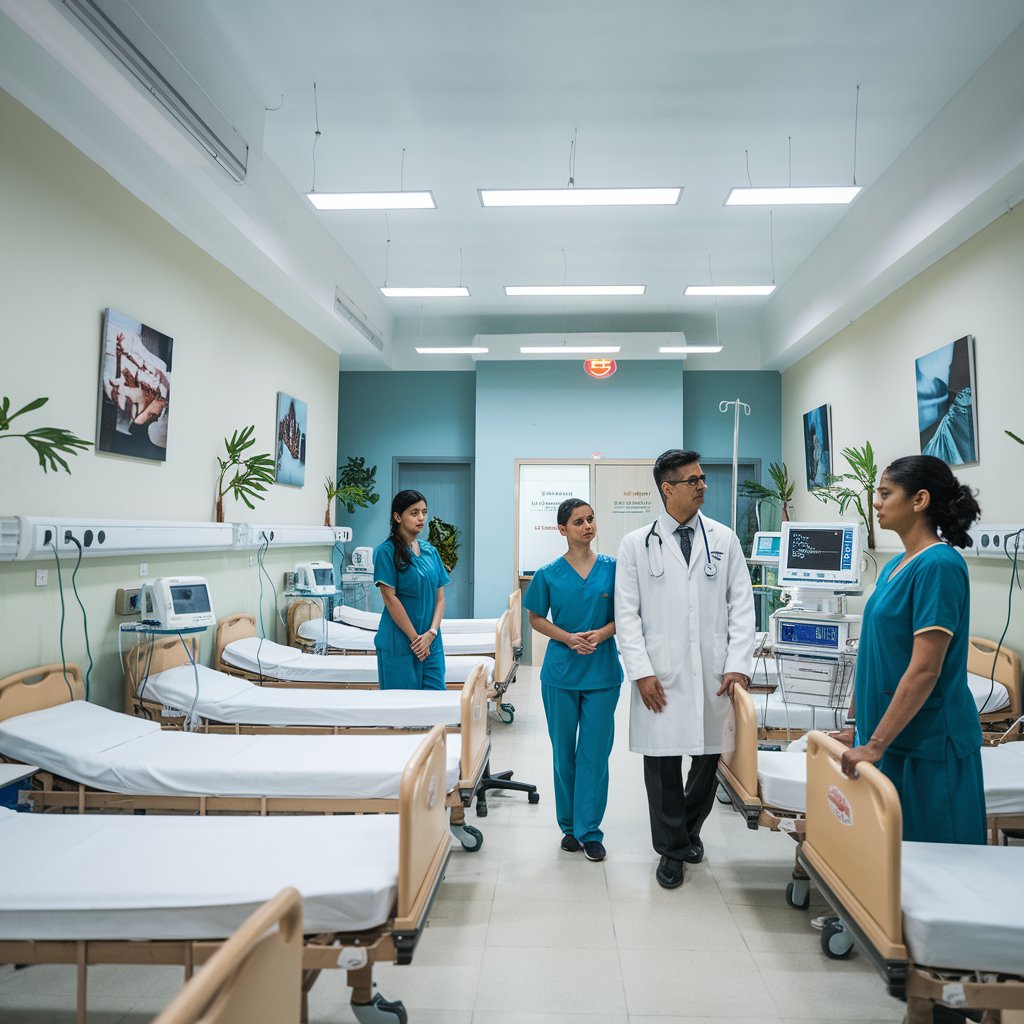Medical Tourism Scenario in India in 2025 has been changing with utmost speed towards more fruitful outcome. The below article provides a glimpse of how Medical Tourism in India is growing in demand with side facilities increment.
Introduction
Medical tourism has emerged as a significant global phenomenon, positioning India as a major player in this industry. This blog post examines a case study based on BMJ Case Reports, exploring the intricacies of medical tourism in India, including the factors driving this trend, its benefits and risks, and its impact on Indian healthcare and the global medical landscape.
India has been ranked 10th in Medical Tourism Index (MTI) for 2020-21 out of 46 destinations of the world by Medical Tourism Association. Global Wellness Institute has estimated the global wellness tourism market to be USD 639 Billion in 2017 with Secondary wellness travellers accounting for 89% of the trips and 86% of the expenditure. Domestic wellness travel contributing 82% of total trips and 65% of expenditure.
United States, Germany, China, France, Japan, Austria and India are the leading countries for
wellness tourism in terms of the size of wellness tourism market.
Overview: The Development of Medical Tourism in India
India has emerged as a premier destination for medical tourism because of various factors:
- Cost-effectiveness: Medical procedures in India often cost significantly less than in developed countries, sometimes up to 80% less for complex surgeries.
- Quality of care: Many Indian hospitals offer state-of-the-art facilities and highly skilled medical professionals, often trained in Western countries.
- Minimal wait times: Patients can often receive immediate treatment, avoiding long waiting lists frequently in countries with public healthcare systems.
- English proficiency: Widespread use of English in India’s medical community facilitates communication with international patients, reducing language barriers.
- Traditional healing practices: India offers a unique blend of modern medicine and traditional healing systems like Ayurveda, attracting patients interested in holistic approaches to health.
Case Study: BMJ Case Reports on Medical Tourism in India
The BMJ (British Medical Journal) has published several case reports highlighting various aspects of medical tourism in India. Let’s examine three significant cases:
Case 1: Successful Cardiac Surgery
A 65-year-old British patient with severe coronary artery disease opted for bypass surgery in India, citing long waiting times in the UK and high costs in the US.
Outcome: The surgery was successful, with high patient satisfaction. The total cost, including travel and accommodation, was less than 30% of what it would have been in the UK or US.
Key Insights:
- Substantial cost savings for complex procedures
- Quality of care matching international standards
- Reduced wait times for time-sensitive treatments
Case 2: Complications in Cosmetic Surgery
A 45-year-old American woman underwent cosmetic surgery in India but experienced postoperative complications.
Outcome: The patient required additional treatment upon return to the US, highlighting the potential risks of medical tourism.
Key Insights:
- Importance of thorough preoperative screening and post-operative care
- Challenges in managing complications across international borders
- Clear communication and thorough medical records are vital for ensuring effective treatment and maintaining continuity of care.
Case 3: Innovative Cancer Treatment
A Canadian patient sought innovative cancer treatment not yet approved in their home country.
Outcome: The patient received novel immunotherapy treatment in India with promising results.
Key Insights:
- India’s potential as a hub for advanced medical research and treatments
- Ethical considerations surrounding access to experimental therapies
- Medical tourism’s role in accelerating global access to new treatments

Analysis of the Case Studies
These BMJ case reports provide valuable insights into medical tourism in India:
1) Level of Concern
Premier Indian hospitals can deliver exceptional medical services that match Western quality standards. However, quality varies across facilities, emphasizing the importance of thorough research and choosing accredited institutions. Patients should look for hospitals with global accreditations, such as those provided by the Joint Commission International (JCI), to ensure top-tier healthcare quality. These certifications assess various elements of medical services, including patient safety measures, infection control protocols, and staff credentials.
2) Affordability
Medical procedures in India often cost 50-80% less than in developed countries, even when including travel and accommodation expenses. This cost advantage is a primary driver of medical tourism to India. For instance, a heart bypass surgery that could cost $100,000 in the United States may be available for just $10,000 in India. However, patients need to consider possible hidden expenses, like those arising from complications or prolonged hospital stays, which could greatly inflate the total cost.
3) Regulatory and Ethical Considerations
The case reports raise questions about regulatory oversight and ethical considerations, particularly regarding experimental treatments and managing post-operative complications across borders. Patients must understand the legal and ethical regulations that oversee medical procedures in India and recognize how they vary from the standards in their own countries. For instance, some treatments available in India might not be approved by regulatory bodies like the FDA in the United States, raising questions about safety and efficacy.
4) Impact on Local Healthcare Systems
It’s crucial to consider the impact of medical tourism on India’s domestic healthcare system, including potential strain on resources and effects on access to care for local populations. This situation raises questions about healthcare equity and the responsibility of the medical tourism industry to contribute to local healthcare infrastructure. Some argue that the profits generated from medical tourism can improve overall healthcare quality, while others are concerned it may lead to a two-tiered system.
5) Patient Experience and Cultural Sensitivity
Cultural sensitivity and clear communication are vital in ensuring positive patient experiences. Communication challenges, variations in medical practices, and cultural differences can affect both patient satisfaction and treatment outcomes. Hospitals catering to medical tourists often provide dedicated international patient services to address these concerns, including language interpreters, cultural liaisons, and assistance with travel arrangements.
Challenges and Risks in Medical Tourism
The BMJ case reports highlight several challenges and risks:
- Continuity of care: Ensuring proper follow-up care and managing complications after patients return home can be challenging, especially for complex procedures.
- Legal recourse: Seeking legal recourse across international borders in instances of medical negligence can be complex, time-consuming, and often impractical.
- Insurance coverage: Many insurance plans don’t cover treatments received abroad, leaving patients financially vulnerable in case of complications.
- Infection risks: Exposure to pathogens and potential antibiotic-resistant bacteria can pose risks to international patients, particularly in countries with different antimicrobial resistance patterns.
- Ethical concerns: The availability of procedures restricted or unavailable in the patient’s home country raises ethical questions about medical standards and patient safety.
The Future of Medical Tourism in India
Based on the insights from these BMJ case reports and broader industry trends, we can project the following:
- Continued growth driven by cost advantages and improving healthcare infrastructure.
- Increased specialization in specific procedures or treatments, with hospitals developing centers of excellence.
- Enhanced role of telemedicine and digital health technologies in facilitating pre-and post-operative care for international patients.
- The potential emergence of international standards and regulations specific to medical tourism to address some of the challenges highlighted in these case studies.
- Combining traditional healing practices with modern medicine results in unique “wellness tourism” packages that blend medical treatments with holistic health approaches.
Conclusion
BMJ case reports on medical tourism in India highlight the opportunities and challenges of this growing industry. Patients enjoy cost savings and the availability of innovative treatments, but concerns persist regarding risks such as complications and problems with follow-up care. As medical tourism develops, it is essential to focus on the quality of care, ethical considerations, and efficient management of complications. Patients considering medical treatment in India should thoroughly research accredited hospitals and plan for comprehensive follow-up care. With ongoing improvements and a focus on ethical standards and international collaboration, India can continue to strengthen its reputation as a leading destination for affordable, high-quality medical care.



